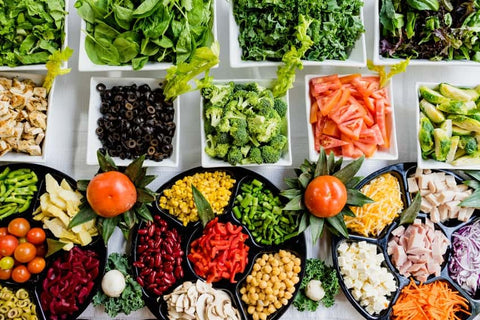As you may be aware, the key to weight loss is to consume less food and move more. While this is grossly simplified advice, is it the backbone of how fat loss works—calorie balance, or calories in vs calories out.
We have to be in a calorie deficit for a prolonged period in order to lose fat, though it’s trickier than it sounds.
Many weight-loss diets centre around this concept, advising calorie restriction and increased exercise and activity.
While this can be an effective and sustainable approach for some, others may need more structured and practical advice to underpin this fundamental concept.
This practical advice can be anything from increasing daily step count to decreasing your intake of highly processed foods.
But one of the best bits of advice we’ve heard is to increase your consumption of “volume foods”, or “volume eating”.
Let’s delve into this concept a bit more!
Keep reading to see examples of high-volume foods.
What is Volume Eating?
Volume eating is essentially eating large volumes of food without consuming a large number of calories at the same time. This concept is based on the energy density of all foods.
For example, a pound of broccoli will contain significantly fewer calories than a pound of doughnuts. Broccoli would take up more room in your stomach, thus keeping you fuller for longer with minimal calories being consumed, whereas doughnuts would take up much less room but at the cost of far more calories.
The first and most important point to reiterate here is that you don’t have to eat just vegetables and high-volume foods to achieve fat loss. Any food can be included in your diet, and you can still achieve weight loss.
However, incorporating more high-volume foods into your diet would help bulk out the overall volume of your meals which will keep you satisfied for longer for little calories, thus helping control appetite and support fat loss.
Volume Eating: How Does it Work?
Fruits and vegetables are some of the best volume foods you can increase your intake of. These foods are high-volume and low calorie because of large amounts of fiber and water, which allows you to consume lots of it to keep you satisfied for minimal calories.
Not to mention the nutrient density of these foods alone would support fat loss and be massively beneficial to overall health.
Volume eating allows you to still enjoy the foods you want to eat while dieting but while implementing a couple of strategies that allows you to enjoy them in moderation, prioritising high-volume, nutrient-dense foods.
For example, loading your plate with vegetables before any other food group allows you to prioritise these foods and feel satisfied after your meal.
Being satisfied after a meal would help prevent over-eating in the day and could potentially help curb cravings, particularly in the evening times.
Some other benefits of volume eating include:
- You’ll be consuming much more vitamins and minerals which will help improve health, energy levels, performance, and recovery
- You’ll be getting in lots of fiber, which means better digestive health
- Many volume foods contain lots of water, which will help towards keeping you hydrated
- Seeing a big plate of food for little calories is good for the dieting mindset
Portion Control: Structuring Your Meals
There is a slight crossover with volume eating and general portion control.
When on a diet or otherwise, it’s a great idea to practice portion control so that you’re eating an adequate amount of one food group, and not too much of another.
For example, visually split your plate into 4 quarters: dedicate one quarter to a protein source, one quarter to a carbohydrate source, and half of the plate to vegetables.
This would allow you to consume roughly the correct amount of recommended food groups while loading your plate with 1-2 different types of vegetables, resulting in a satisfying, low-calorie, and balanced meal.
Though, this is more of a general guideline to portion control. It’s important to remember that when it comes to nutrition and diets, there is no one-size-fits-all approach.
Depending on your nutrition and fitness goals, the ratios of foods you are consuming will differ from person to person. For example, you may require more carbohydrates if you’re more active, or less if you’re more sedentary.
Examples of Non-Vegetable, High-Volume Foods
While the best kind of high-volume, low-calorie foods come from fruits and vegetables, there are also other kinds of high-volume, low-calorie foods that are also great options to add to a diet, for example:
- Rice cakes
- Popcorn
- Soup
- White fish
- Oats
- Berries
- Chia seeds
- Potatoes
- Watermelon
Protein sources such as:
- Egg whites
- Low fat Greek yogurt
- Low-fat cottage cheese
- Lean ground meats, such as turkey
- Boneless, skinless chicken breast
Top tip: protein is the most satiating macronutrient, so increasing your consumption of high-volume, low-calorie sources of protein is a very effective strategy for fat loss.
You can even combine some of these foods to make a more well-rounded high-volume meal or snack, such as soups, chia seeds with porridge, cottage cheese with raw veggies, bowls of salad, etc.
Summary
There are many strategies that you can implement to help you achieve or maximize your fat loss results. The most important thing to remember is finding an approach that you can adhere to long-term, as there is no one-size-fits-all.
Volume eating can be a very effective and easy strategy to implement into your daily routine. All it takes is rearranging your plate, consuming more fruits and vegetables, and increasing your intake of good quality protein sources!

